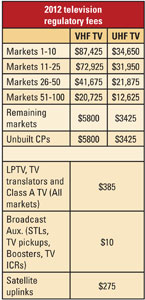Regulatory fees due
By
TVTechnology
published
The final 2012 regulatory fees have been announced by the commission. Table 1 shows the principal fees that apply to commercial television, plus LPTV, television translators and Class A television stations.

Table 1. Shown here are the fees that apply to commercial television, plus LPTV, television translators and Class A television stations.
- Ups and downs. Fees for VHF television licensees in markets 26-50 have dropped nearly $2000 since the commission’s initial proposals in May. VHF licensees in top-10 markets were granted a similar reduction of $7350 — about 8.4 percent — from the May proposals. UHF licensees in the top-20 markets were assessed increases over the May proposals in the range of 2 percent, or about $1000 each. By reducing fees for VHF full-power television stations, the FCC implicitly recognizes the parity of UHF and most VHF frequencies for digital broadcasting when compared to the much lower regulatory fees the FCC has historically assessed against UHF stations.
- Fee window. The FCC established Sept. 13, 2012, as the 2012 regulatory fees deadline. Anyone not paying by then will be assessed a 25 percent penalty and risks “red light” status, which means their applications and reports will not be processed until paid.
- Multicasting. For Class A, LPTV and television translator stations, a single fee will be assessed for each license, regardless of whether they transmit in analog or digital mode, or simulcast in both modes.
- Online refund and waiver requests. Any request for a refund, waiver, fee reduction or deferment of any annual regulatory fee, and of any application fee, must be submitted electronically.The commission’s order provides no information about which online filing system might be used to apply for refunds or waivers. The order specifies no effective date for the new online system; presumably, the OMD will issue a public notice when its refund and waiver processing site is established.
- Bills will not be mailed. Again this year, the commission will not send bills reflecting each station’s fee obligations. To ascertain what fees have been calculated per station, each station must go to www.fccfees.com, enter its call sign or facility ID, and proceed from there. When a dollar figure appears, check it carefully, as the FCC’s postings are sometimes erroneous.
- Paying fees for auxiliaries. The FCC’s fee calculator does not include fees for auxiliary licenses such as TV pickups, STLs, TV boosters and TV ICRs that may be associated with the main license. Thus, licensees should check their own and the FCC’s records to be sure fees for such authorizations are included on their fee remittance forms (Form 159s) and reflected in the ultimate fee payment.
Dateline
- On or before Oct. 1, 2012, noncommercial TV and Class A stations in Alaska, Florida, Hawaii, Puerto Rico, Oregon, the Virgin Islands, Washington, and the Pacific Islands must file their biennial ownership reports.
- On or before Oct. 1, 2012, television stations, Class A TV, LPTV stations and TV translators in Florida, Puerto Rico and the Virgin Islands must file their license renewal applications.
- On Oct. 1, 2012, television and Class A TV stations in Alabama and Georgia must begin their pre-filing renewal announcements in anticipation of a Dec. 3, 2012, renewal application filing date.
- On Oct. 1, 2012, television and Class A TV stations in the following locations must post their 2012 EEO reports on the FCC’s website: Alaska, Florida, Hawaii, Puerto Rico, Oregon, the Virgin Islands, Washington and the Pacific Islands.
—Harry C. Martin is a member of Fletcher, Heald and Hildreth, PLC.
Get the TV Tech Newsletter
The professional video industry's #1 source for news, trends and product and tech information. Sign up below.
CATEGORIES
LATEST ARTICLES
